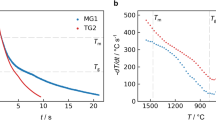Abstract
The effect of gravity (from micro-to a rather high gravity, 5g 0) acting during tellurium crystallization on the concentration of neutral (N D ) and electrically active (N AD ) acceptor-type structural defects in samples grown both under complete remelting of the starting ingot and under directed seed recrystallization of an ingot was studied. The concentrations N AD and N D and their distribution over the sample length were derived from the electrical characteristics (conductivity and the Hall effect) measured along the ingots in the temperature range 1.6–300 K. The contributions of various mechanisms to hole scattering were found from an analysis of the temperature behavior of the mobility. The results obtained were compared with the characteristics of samples grown following a similar program under normal conditions. The presence of N AD defects is characteristic of the initial crystallization stage of all samples. N AD is substantially lower (N AD ∼ 1015 cm−3) than N D ∼ 1018 cm−3 and decreases exponentially in the course of sample crystallization. Complete remelting under microgravity revealed indications of strong supercooling and spontaneous crystallization, as well as spatial oscillations of the electrical resistivity over the sample length caused by N D modulation. These observations are related to the specific features of the melting and crystallization in zero gravity, namely, the melt breaking away from the wall of the ampoule and the increasing role of Marangoni convection.
Similar content being viewed by others
References
L. L. Regel’, I. V. Vidensky, A. V. Mikhailov, et al., in Proceedings of the International Astronautical Congress, Innsbruck, Austria (Pergamon, New York, 1986).
P. Grosse, Die Festkörpereigenschaften von Tellur (Springer, Berlin, 1969), Springer Tracts in Modern Physics, p. 48.
Landolt-Börnstein: Numerical Data and Functional Relationships in Science and Technology, New Series (Springer, Berlin, 1983), Group III, Vol. 17.
L. L. Regel’, A. M. Turchaninov, R. V. Parfeniev, et al., J. Phys. III 2(3), 373 (1992).
R. V. Parfen’ev, I. I. Farbshtein, I. L. Shul’pina, et al., Fiz. Tverd. Tela (St. Petersburg) 42(2), 238 (2000) [Phys. Solid State 42, 244 (2000)].
R. V. Parfeniev, I. I. Farbstein, S. V. Yakimov, et al., in Proceedings of Joint 10th European and 5th Russian Symposium on Physical Sciences in Microgravity, St. Petersburg, Russia, 1997, Vol. 2, p. 56.
I. I. Farbshtein, Author’s Abstracts of Candidate’s Dissertation (Inst. Poluprovodnikov Akad. Nauk SSSR, Leningrad, 1965).
H. Rodot, L. L. Regel’, and A. M. Turchaninov, J. Cryst. Growth 104, 280 (1990).
V. S. Avduevskii, S. D. Grishin, and L. V. Leskov, Scientific Reading on Aviation and Cosmonautics, Year 1980 (Nauka, Moscow, 1981), pp. 15–24.
A. R. Regel’ and V. M. Glazov, Physical Properties of Electronic Melts (Nauka, Moscow, 1980).
W. A. Arnold, PhD Thesis (Clarkson University, Potsdam, 1994).
R. V. Parfeniev, I. I. Farbshtein, S. V. Yakimov, et al., Acta Astronaut. 48(2–3), 87 (2001).
I. I. Farbshtein, A. M. Pogarskii, and S. S. Shalyt, Fiz. Tverd. Tela (Leningrad) 7(8), 2383 (1965) [Sov. Phys. Solid State 7, 1925 (1965)].
C. Erginsoy, Phys. Rev. 79, 1013 (1950).
L. L. Regel’ and W. R. Wilcox, Microgravity Sci. Technol. 14, 152 (1999).
Author information
Authors and Affiliations
Additional information
__________
Translated from Fizika Tverdogo Tela, Vol. 44, No. 7, 2002, pp. 1190–1197.
Original Russian Text Copyright © 2002 by Parfen’ev, Farbshte\(\overset{\lower0.5em\hbox{$\smash{\scriptscriptstyle\smile}$}}{l}\)n, Shul’pina, Yakimov, Shalimov, Turchaninov.
Rights and permissions
About this article
Cite this article
Parfen’ev, R.V., Farbshtein, I.I., Shul’pina, I.L. et al. Defect formation in tellurium in various gravity conditions. Phys. Solid State 44, 1241–1248 (2002). https://doi.org/10.1134/1.1494616
Received:
Issue Date:
DOI: https://doi.org/10.1134/1.1494616



